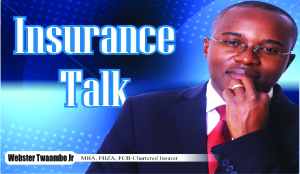 NO doubt, excess is one thing that is least appreciated by many people. When one hears the word excess usually what comes to mind is having more than enough or abundance but in insurance this word has a special meaning.
NO doubt, excess is one thing that is least appreciated by many people. When one hears the word excess usually what comes to mind is having more than enough or abundance but in insurance this word has a special meaning.
Simply put it refers to an uninsured loss. It is that portion of the claim that is not paid or covered by the insurance policy but paid by the insured.
If we break it down further a client who buys insurance is not hundred per cent covered when they make a claim. In most cases excess is ten percent of the claim with a minimum retained liability of some specific amount for example K500 in private motor insurance.
A typical excess clause reads as follows; ‘the insured shall be responsible for 10 per cent of each and every claim subject to a retained minimum liability of K500.’
Interpreting this means than if one has a claim of say K10,000 then they will pay excess of K1,000.
But the scenario changes if someone has a claim of K2,000.
Instead of paying ten per cent which is K20 they will pay K500 i.e. the minimum excess amount.
In a third scenario if someone has a loss of say K400 then they cannot claim under the policy as this falls within excess amount. In other words insurance pays ninety percent of what is insured.
Excess can either be compulsory or voluntary.
Compulsory excess is the type of excess where the client has no choice but to live with, it is not negotiable.
On the other hand voluntary excess is where a client willfully offers to have the excess increased to some higher amounts sometimes known as a deductible. There are many reasons that may prompt the client to do this.
The first reason is that of discounts that come with the same. A client after analyzing their losses over a period of time may offer to retain some considerable portion say K10 thousand.
This means that any loss that is less than K10,000 the client will not claim. A reduction in premium in such a scenario is definitely attracted.
A deductible should not be confused with a franchise. Whereas the deductible is a loss paid by the insured a franchise is a threshold whereby if a loss is below that threshold then the claim will not be paid but if the claim is above the threshold then it will be paid in full.
Taking an example of a K10,000 franchise; if there is a loss of K9,000 then the client will not be able to claim but if the loss is K11,000 then a client will be paid the entire amount.
This is popular in commercial insurance.
So what is the whole rationale behind excess or deductibles? Well, varied reasons may be advanced but I will discuss the most obvious namely the participation of the client in a loss and eliminations of ‘small’ claims.
The fact that a client will contribute a portion of the claim means that there is a sense of responsibility on the part of the client.
In motor insurance for example if two garages with similar workmanship issue two quotations with a huge difference for the same job the client will not insist on having their vehicle repaired by the garage with a higher quote knowing that the higher the repair costs the higher the excess.
Who after all would want to pay more for the same quality of works?
The other reason is to prevent smaller claims which are within the means of the client so that insurance is reserved for bigger losses. Put another way, it does not make economic sense to make a claim where there is a loss that falls within excess.
Let me end our discussion by stating that excess in certain cases may be waived. In specific claims such as wind screens some insurers may waive the same.
There is also what is known as faultless excess waiver clause especially in commercial insurance. With this clause the insured will not pay excess if they were not at fault.
•The author is a chartered insurer with ten years industry experience
Comments:webster@picz.co.zm, webster_tj@hotmail.com,or facebook search for Insurance Talk-Zambia page or call/text 0977857055






